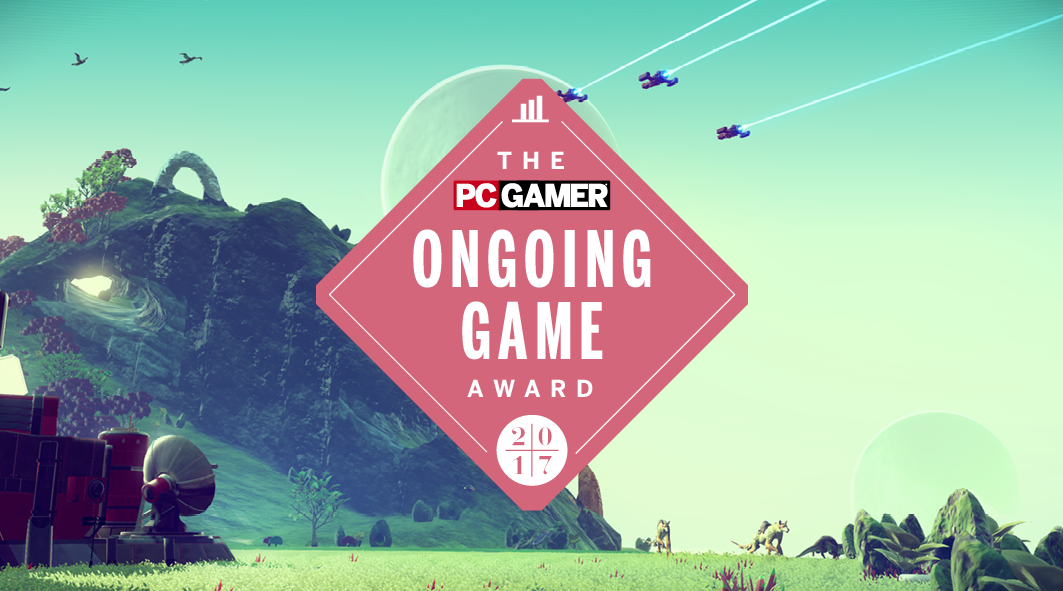
Our Ongoing Game award goes to No Man's Sky. After a rocky 2016 launch, the game's in better shape after this year's updates. Check out our other GOTY awards here.
Phil Savage: Here's a new category for this year's awards, designed to recognise an older game that had a great 2017 through patches and free updates. And whatever you originally thought of No Man's Sky when it released last year, this year marked a period of significant growth and improvement.
Andy Kelly: At launch No Man's Sky felt like a shell of a game. I squeezed 20 hours out of it, which is not insignificant, but in that time I felt like I'd experienced everything this supposedly infinite universe had to offer. But over time, thanks to a procession of hefty free updates, the game has evolved into something much deeper and ultimately much better. Whether it's base-building, vehicles, new biomes, or the story's clearer, more hand-crafted structure, Hello has slowly been transforming the game into something approaching the grand promise of those early demonstrations. I still think there's a lot of room for improvement, including more varied planet surfaces, but the developer's efforts to expand, deepen, and improve its colourful space simulator is something I think we should celebrate.
These updates don't erase launch criticisms but they do reframe the game.
Philippa Warr: I was one of those people who actually loved No Man’s Sky when it came out. Not in an all-encompassing passionate frenzy which blinded me to its shortcomings, nor the differences between marketing and game, but there was so much in that ambitious universe which already gave me joy. It was built for pottering in a way that reminded me of meandering along country trails with my camera, investigating pleasing views and tailing odd creatures.
The first big update to the game—Foundation—came towards the end of 2016 bringing things like base building, freighters and farming. In terms of how that made the game feel, it didn't specifically impact how I played it because I wasn't interested in commerce or on settling down. I was content to drift along in normal mode.
But, taking a more general view, the update felt like a statement from developers, Hello Games, about how they would be approaching the game post-release. The update implied a willingness to be more flexible over what the game could be—instead of forcing players to keep moving, never settling, base-building was a specifically supported element of the game. There were also a couple of modes to tweak the difficulty should you fancy it.
Foundation ended up being exactly that—a support structure and a statement of intent for 2017’s set of updates. Path Finder was the first and offered up vehicles, vehicle racing, base sharing, photo mode, permadeath mode, a whole bundle of quality of life improvements and more. It was photo mode which absolutely blew me away and either ruined or perfected the game for my purposes, depending on which way you approach it.
The biggest gaming news, reviews and hardware deals
Keep up to date with the most important stories and the best deals, as picked by the PC Gamer team.
Photo mode was developed in collaboration with Dead End Thrills’s Duncan Harris. It lets you pause the game in the middle of what you're doing and switch into a free-ish camera mode. At that point you can line up your shots, apply filters as you might on Instagram, fiddle with FOV and depth-of-field, change the position of the sun in order to get the perfect shadows or the exact right time of day and more. Where I used to spend minutes on shots, I can now spend hours. I have previously spent entire sessions within the same five foot radius captivated by different light effects on a group of trees.
I believe Chris Livingston rather liked photo mode too, but the big draw for him in that update was the ability to ram wildlife with his new space car. Perhaps we should have combined our interests for some kind of artsy inverse Wildlife Photographer of the Year exhibition.
Atlas Rises came in August and, along with terrain editing and ancient portals, it seemed to sow seeds for co-op play. Multiplayer, or rather the ability to "see" other people in your game is one of the big sticking points from launch—the reality of the game didn’t match what had been described during development. The ability still isn't exactly in the game but there's a version of the idea in that you can see other players as floaty orbs with proximity-based chat, and Hello Games are billing that as a precursor to some kind of synchronous co-op.
These updates don't erase launch criticisms but they do reframe the game. Hello Games are using the process of post-release patches to respond to those criticisms and flesh out the game in ways that reflect and expand how people play it. More specific to my own interests is the fact that the game just keeps getting more beautiful through a multitude of changes both big and small. In my current game I’ve discovered a planet populated with trees that sprout octopus-like tentacles. Finally I’m ready to call somewhere home. I just have to stop taking pictures of it long enough to find a habitable base and claim the world as my own...
For more recent No Man's Sky words, check out Chris's experiences with the game's synthetic planets and other varied environments.
The collective PC Gamer editorial team worked together to write this article. PC Gamer is the global authority on PC games—starting in 1993 with the magazine, and then in 2010 with this website you're currently reading. We have writers across the US, UK and Australia, who you can read about here.


